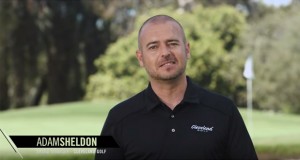The prospect of taking golf lessons can be daunting for the average recreational golfer. For starters, professional golf instruction can be expensive. Also, some people are simply too shy or uncertain to subject their swing to hands-on instruction out on the local driving range or practice green. Into this picture steps Brant Kasbohm, golf instructor and founder of FixYourGame.com, a new service that offers online interactive golf instruction. You film your swing and putting stroke, then submit it to the web site. Then, within 48 hours, you receive a video analysis with tips and advice. One lesson costs $19.95, while a package of five costs $49.95. There is also a two-lesson option for $29.95. PutterZone.com recently spoke with Brant about his service. Following is our exclusive interview:
Can you describe FixYourGame.com, what it offers and how it’s different from other online instruction models?
Fixyourgame.com provides online instruction that is fast, easy affordable, effective and, most important, personalized to each individual student. Each video submitted is reviewed by a PGA professional, and each student gets specific instruction, both video and written, related to the faults in their swing. It’s easy to use. Students send in a video and within 48 hours, receive a complete analysis back. Other online models are general in nature when students view videos of teachers demonstrating proper techniques. But Fixyourgame.com is about you–your game, and your swing. If you have specific questions, or things you want to work on, that’s what we do. We also operate on a pay-as-you-go model, like traditional golf lessons. We do not charge and monthly or yearly subscription fee. And Fixyourgame.com sends all lesson analyses to students via email attachments, so the file is yours to keep forever–you don’t have to log in to the site to view your video.
Some top putting instructors advocate a more upright setup, while others prefer a more crouched stance. Some advocate a pronounced arcing stroke while others prefer a slight arc or straight-back stroke. The list varying viewpoints is pretty long. Does FixYourGame.com have it’s own defined viewpoint around which your putting instruction is centered?
There are some basic fundamentals that we focus on and we break it down into three areas: proper set-up, including balanced weight, posture with spine straight, eyes over ball, and alignment; one piece stroke using the large muscles of the shoulders, and green reading, which is the most underrated and least understood golf skill of all. Outside of these core fundamentals, a lot of putting is personal preference. So if someone is more confident standing tall, as long as their eyes are over the ball with good posture, they should go with it. Same is true for being crouched, etc. We want a student to swing the putter by rocking their shoulders back and forth in a one piece motion with no lower body movement or hand and wrist action. On short strokes, the club can go straight back & through, but on longer strokes, it’s natural for the club to come inside-to-inside. But the key is to have no manipulation of the club with the wrists and hands.
Much of the common putting instruction is so scientific and technical, that it is way beyond the average person, and it assumes that a student has a proper set-up and reads the greens properly, which as an instructor, I never see. I guess my point is that it’s great to know what the perfect speed to hit a putt is, and whether a face balanced, or toe heavy putter is better, but what good does that do if I’m aimed two feet left of my target? And the overly technical analysis of putting neglects the natural randomness that is involved. You can do everything right, but if your ball hits a leaf–which famously happened to Mickelson at the Masters this year–your putt is not going in. So we also do a lot of coaching on top of the teaching of fundamentals. It’s important to remember that both the ball and the hole are very small, and everyone misses putts.
What are your thoughts on having your eyes not directly over the ball at setup, but rather slightly inside the target line, as recommended by Stan Utley and some other leading instructors?
The main reasons I want most players to set up with the eyes directly over the ball is to get the best read, and to get aligned properly to that read. With your eyes over the ball, it is easier to get a true read of the line at address. With the eyes inside or outside the ball and target line at address, the player may have a different read than when standing behind the ball and looking down the line. And this discrepancy can lead to indecision, which is the killer of all golf shots. I compare it to shooting a rifle–you want to look directly down the barrel to the target. That’s what’s happening when your eyes are directly over the ball. You’re not going to shoot a rifle accurately when holding at arm’s length. In some cases, I will recommend a player keep their eyes inside the ball, and that is when he or she takes the club back outside the line, and cuts across the ball at impact. But the player has to be confident in their reads and alignment. Keeping your eyes inside the ball encourages an inside-to-square-to-inside path, which is good, but if you’ve misread the putt, or are misaligned, what good does that do? The vast majority of amateurs are not aligned where they think they are, and that leads to compensations in the stroke. Having the eyes over the ball increases the chance that a player will be set up square to their intended line.
Are putter fitting suggestions included in your instruction? For example, what if you see someone who’s setup looks good, but whose putter toe is sticking up in the air—do you tell them to adjust their lie angle? What if their putter looks to long or short?
Absolutely. Being properly fit is key to making a repeatable stroke. Equipment wise, we see on a very regular basis that people use a putter that is too long, and therefore they have a tendency to set up with their eyes inside of the ball instead of over the ball. This also causes the toe to stick up, which causes putts to go left, which causes people to alter their stroke to get the ball on the correct line. For example, I’m 6’0″ tall, and my putter is 34″ long, but most off the rack putters are 35″ long, and most people, especially women and juniors, are not six feet tall. Also, we generally recommend people use a heavier putter to help encourage a stroke with the large muscles of the shoulders. A heavier putter is also less likely to be manipulated with the hands or wrists.
What is the most common putting mistake that you see, and can you share a simple tip for helping to fix it?
The most common flaw that I see in putting is that when reading greens, people do not look at the entire length of the putt. They typically look at the area around the hole, and around the ball, but neglect the middle part of the putt. So if they have a putt longer than four to five feet, they’re failing to read a significant portion of the ball, and therefore making their putts a matter of luck. So a tip to fix this is simple–look a the entire length of the putt, you’ll see breaks and elevation changes that are not present, and previously ignored. Stroke wise, the most common flaw is the use of the hands and wrists to make the stroke, and not rock their shoulders back and forth. Using the hands and wrists adds a huge degree of timing into the stroke, and therefore a huge degree of inconsistency. A tip to help correct this is to take practice strokes with another club tucked under both your armpits, and across your chest. This helps you feel the shoulders rock during the stroke.
Thanks, Brant! Stay tuned for future Insider Interviews on PutterZone.com.
 PutterZone – Best Putter Reviews
PutterZone – Best Putter Reviews





after following all the instructions on putting, i just missed a three footer to win the match against lehmkuhl. what can i do?
One point of agreement and one point of criticism.
On putter length I'm in full agreement, I think everyone should go out right now and cut 1.5" off of their putter. I'm also 6' and I use a 34" putter. I have used 33" putters in the past with success. 35" is way too long for just about everyone. The explanation I give is to think of a pendulum. The longer the string on a pendulum, the farther the weight can swing. The longer the shaft on your putter, the farther off-line your swing can get.
My point of contention is putter weight. I used to be in this same school of thought until I tried a TigerShark grip on one of my putters that drastically lowered the swingweight. The putter felt better and I was less likely to muscle shots around. This theory was cemented for me when I got my m3. The m3 came with a stock GOP grip. Swingweight was D3 or so. I put a large Iomic on and now that swingweight is about D0 and it feels much more stable. I go back to the pendulum. A heavier pendulum is going to swing off-line farther if pushed that way. C8-D0 is where I like my putters to swingweight at so that I can feel like the putter isn't driving my arms. Of course, everyone is different here.
Putter length is a pretty hot topic. The instructional trend is toward shorter putters, but some of the top guys like Utley and O'Brien are saying, not so fast.